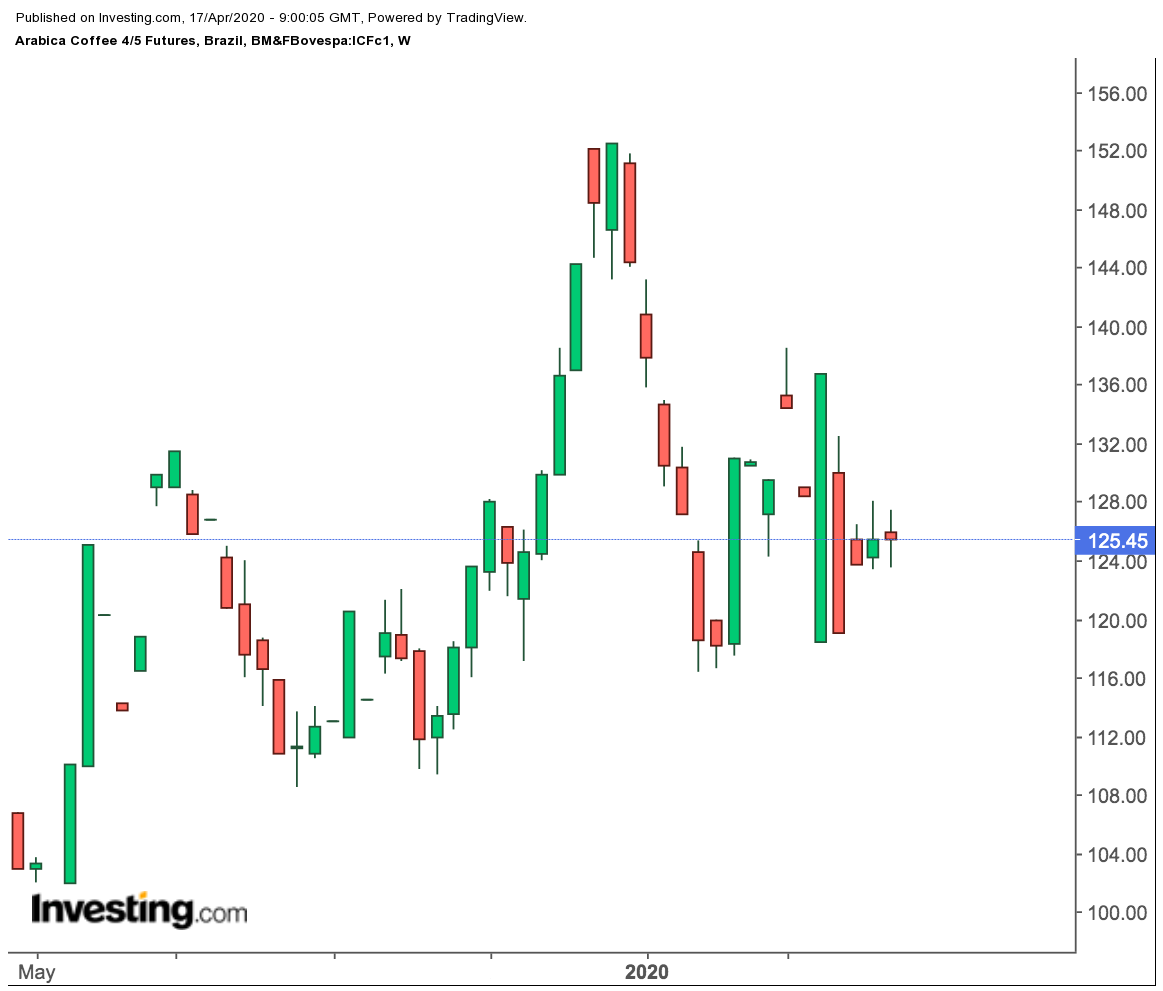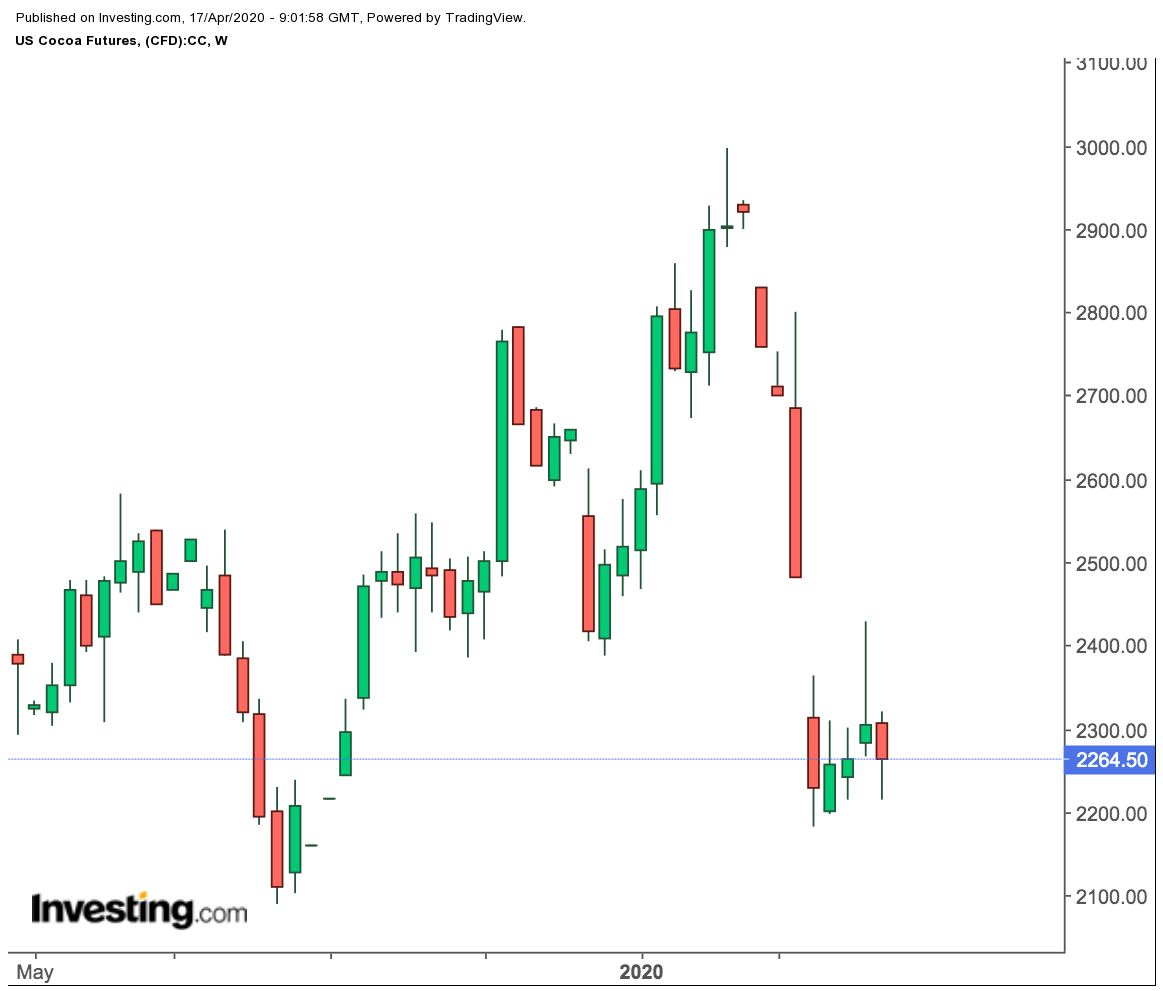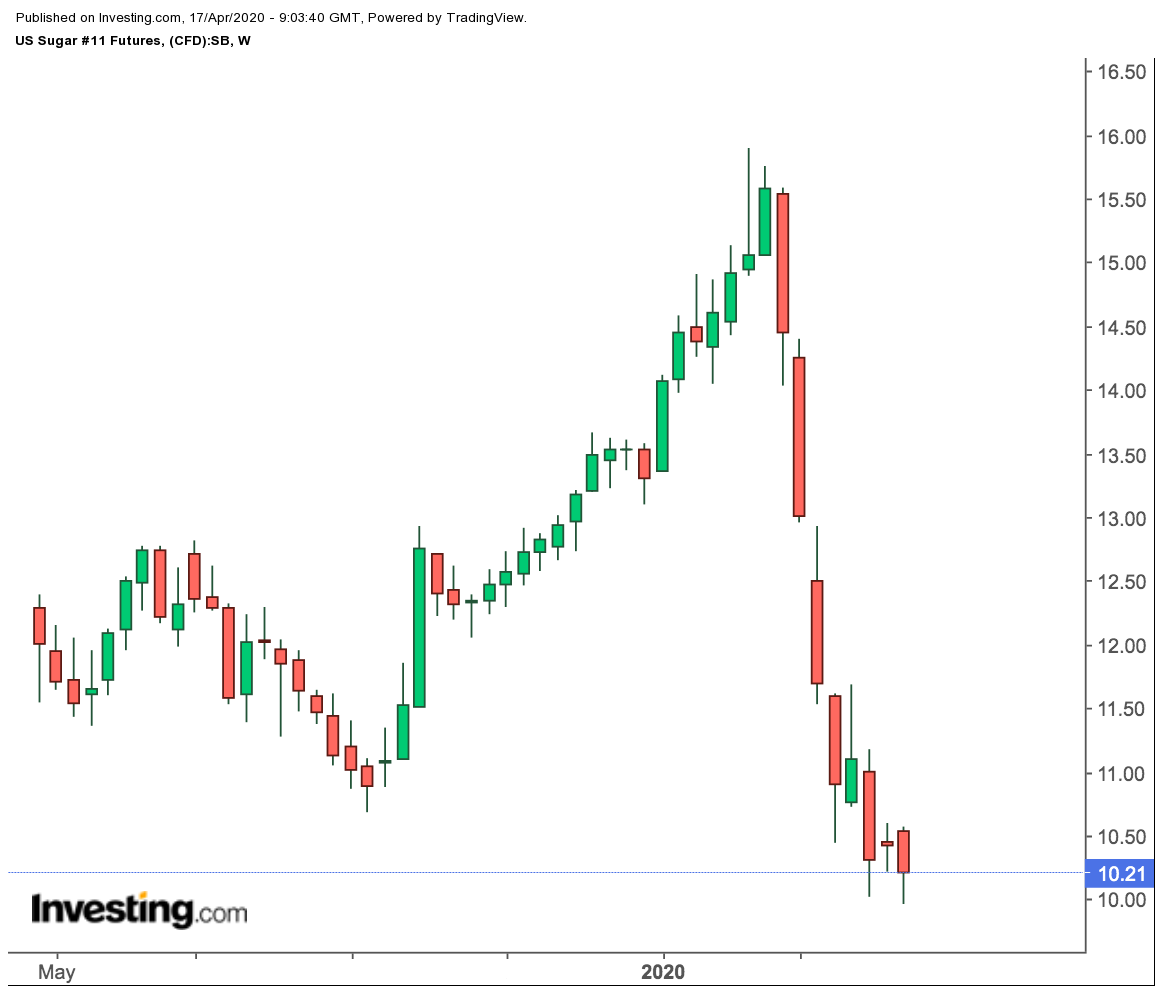Before the OPEC deal was finalized at the weekend, I wrote that oil will probably be going to hell in a handbasket if the cartel and the rest of the world don’t agree on cuts. Five days later, crude prices are no closer to heaven, even with the so-called GLOPEC deal to remove 10 million barrels per day.
Anyway, the point of this post is several readers had asked for my thoughts on other commodities that were largely ignored by the oil-and-gold saturated coverage of the past week.
Many were particularly interested in “softs” such as coffee, cocoa and sugar. Each of these markets experienced different outcomes from the coronavirus crisis, and this is a review of their recent action and where they could be going.
The observations are based on my own reading of Investing.com charts and views from softs analysts, Jack Scoville of Price Futures Group and Clif Droke of Financial Sense Wealth Management.
COFFEE
Just before the global explosion of COVID-19, arabica coffee, the benchmark blend for the Americas and most of the coffee world in Europe and the Middle East, tumbled to a near four-month low of 97.40 cents per lb on Feb. 6.
From there, it surged nearly 35% to hit a 12-week high of $1.3065 on March 26.
Since then, arabica has been whipsawed by volatility, losing a net 8% to reach the April 16 settlement of $1.2020.
The question is whether there’s any upside left to arabica in the near-term of it’s time for longs to bail out completely.
Sideways Near-Term
“A sideways coffee price trend is likely in the near-term,” Droke wrote in an April 16 outlook. “Further out, stimulus-related inflation will push coffee prices higher.”
Confusion and uncertainty are the watchwords in the coffee market right now, according to Droke. “At least that’s apparently the case based on the lack of a consensus on how COVID-19 will affect bean prices. I’ll make the case here, however, that while prices might remain directionless in the near term, coffee’s intermediate-term (3-6 month) outlook is bullish based on currency-related factors.”
“If there’s one thing that is certain in the industry right now, it’s that no one is certain how the global pandemic will ultimately impact the java market,” he says.
Mixed Signals on Supply-Demand
For example, he cites the International Coffee Organization’s latest supply-demand report, which estimated 2019/20 global coffee consumption at 0.7% above the previous year, while adding for good measure that COVID-19 represents “considerable downside risk to global coffee consumption."
To conclude, Droke said the overall international demand for coffee was still strong enough to support the market even in the face of the pandemic. “Supply chains are still being disrupted due to the virus, which is another potentially supportive factor in the near term. However, as South American bean harvesting season is about to get in full swing, some of coffee’s supply-related pressures could be alleviated, thus resulting in a sideways price trend for coffee.”
Strong Intermediate Trend
Droke adds:
“I further expect U.S. currency weakness to intensify in the coming months, which should support a rising intermediate-term trend and push coffee prices up and out of their current ranges.”
Scoville agrees that arabica isn’t ready to collapse yet, by the looks of it.
“The commercials are playing the long side and the market is not going down,” he said. “The chart trends are mixed in New York and still mostly down in London due to big production ideas, but producers are having trouble getting workers to pick and the exporters are having trouble getting workers for processing and loading.”
Scoville said giant arabica producer Brazil was reporting good growing conditions with a few showers. “It is dry in other parts of Latin America. Central America has had less than normal rains, especially in Honduras,” he added.
So what’s the technical picture for arabica?
Investing.com’s Daily Technical Outlook still suggests a “BUY”.
My reading of the near-term Fibonacci levels for arabica suggests first major resistance at $1.2119, then $1.2275 and finally $1.2527.
On the downside, if the bearish streak continues, first Fibonacci support is $1.1615, then $1.1459 and finally $1.1207.
COCOA
COVID-19 was a major unforeseen event that crushed the gourmet chocolate market by February as the pandemic peaked in China, said Barry Callebaut, one of the world's top cocoa grinders and confectioners, with an average annual output of 2 million tonnes.
New York-traded cocoa went from a pre-COVID-19 high of $2,998 per tonne on Feb. 19 to an eight-month low of $2,183 on March 25. That constituted a 27% drop. It, however, recovered over the past three weeks to settle on April 16 at $2,265.50.
Unquantifiable Impact
“While we have put in place precautionary measures to support the continuation of our operations, its impact on business growth and profitability cannot be quantified at this stage as it depends on the duration and severity of the pandemic,” Barry Callebaut said, adding that Nielsen data on underlying market growth for Asia Pacific had also been rendered incomplete.
Yet, the company said it was relying on its global footprint, innovation pipeline and customer diversity and channels to overcome the pandemic. “In the meantime, we remain committed to our mid-term guidance for the period ending with fiscal year 2021/22,” it added.
First quarter cocoa grinds were moderately down in Europe and North America and much lower in Asia, complicating the outlook picture for cocoa.
“Chart trends are still turning down in both markets as the coronavirus helps keep demand away and helps keep workers from grinding facilities and chocolate manufacturers,” Scoville said.
“Strong Sell”
Scoville adds:
“Harvest is now over for the main crop in West Africa and the results so far are very good. Ideas are that demand is less than before due to the Coronavirus problems in Europe. The reports from West Africa imply a big harvest in the region. The weather in Ivory Coast is good. The weather is too dry in Ghana and Nigeria and there are fears that the mid crop is not developing well at this time.”
On the technical front, Investing.com’s Daily Technical Outlook calls for a “STRONG SELL” on cocoa.
Precisely on Fibonacci levels, the downside sees first support at $2,192.28, then $2,179.06 and finally $2,157.67.
Up on the upside, first Fibonacci resistance is at $2,235.06; second at $2,248.28 and third at $2,269.67.
SUGAR
In sugar’s case, consumers around the world were hoarding refined sugar due to the coronavirus, Droke said.
But global sugar demand was, nonetheless, lower due to restaurant closures, he added.
“Higher sugar supply from Brazil is also expected later this year,” he said. “A defensive posture is recommended until the pandemic has ended.”
Despite retail-level stockpiling, however, worldwide sugar demand is actually expected to drop considerably due to the pandemic.
Industry researcher Czarnikow Sugar recently forecast a 2-million-ton drop in global sugar consumption owing to the virus. In the note, analyst Ben Seed said aside from the consumption decline in the 2019/20 season, worldwide sugar consumption in 2020 was likely to be lower on a per capita basis.
Hoarding Hasn’t Helped Sugar’s Demand
Droke said despite a rush among individual shoppers in several major countries to hoard sugar in the face of COVID-19, traders shouldn’t expect to see higher futures prices soon.
This was because sugar demand on the retail level was likely to remain subdued for as long as quarantines and lockdowns were in place in various countries, he said.
“Moreover, traders will need to watch for a potential increase in sugar supplies from Brazil in the next few months as its harvest season gets into full swing this spring. In view of these factors, a heavy cash position is recommended for now as we wait for the damage inflicted on the market by the coronavirus to abate,” Droke added.
New York-traded sugar went from a near three-year high of 15.90 cents a lb on Feb. 12 to a near three-year bottom of 9.96cents on April 15. That constituted a plunge of 37%.
Cheap Oil Another Problem
Low oil prices were also a drag on sugar, which was a major feedstock for the biofuel ethanol, said Scoville.
He adds:
“Concerns that ethanol production will not start to increase anytime soon is still a drag on futures prices. The recently weaker petroleum futures make higher priced ethanol that much more expensive to blend and cuts demand. There’s still a long way to go before ethanol processing becomes profitable again. That makes more sugarcane available for processing into sugar.”
Investing.com’s Daily Technical Outlook for sugar calls for a “STRONG SELL”.
My reading of a further depth for sugar shows first support at 9.91 cents, then at 9.88, then finally at 9.85.
